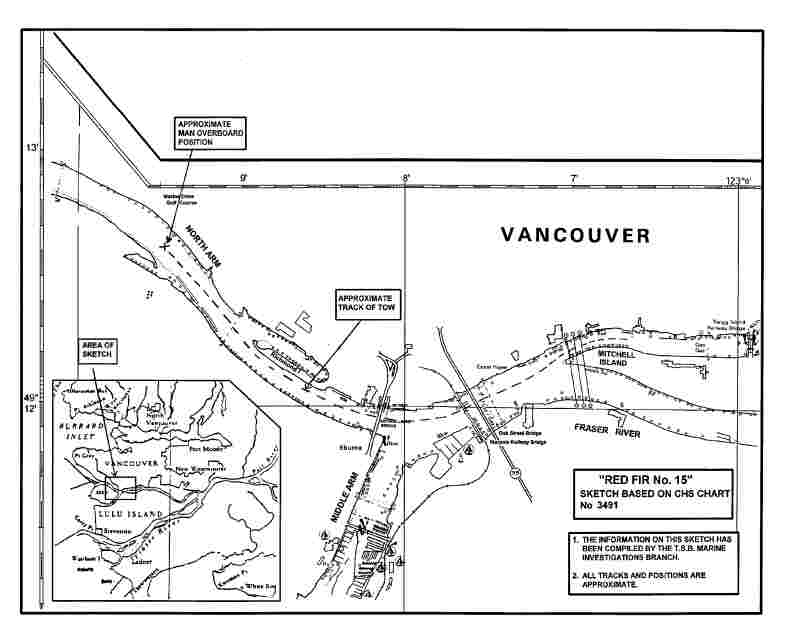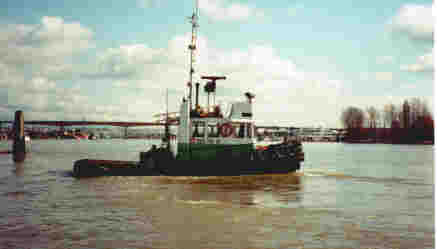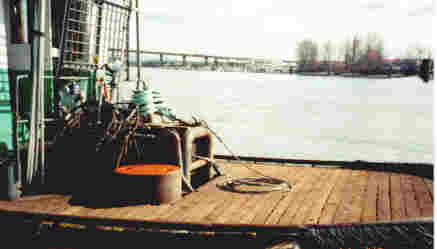Man overboard from the small tug "RED FIR NO. 15"
North Arm of the Fraser River, British Columbia
The Transportation Safety Board of Canada (TSB) investigated this occurrence for the purpose of advancing transportation safety. It is not the function of the Board to assign fault or determine civil or criminal liability. This report is not created for use in the context of legal, disciplinary or other proceedings. See Ownership and use of content. Masculine pronouns and position titles may be used to signify all genders to comply with the Canadian Transportation Accident Investigation and Safety Board Act (S.C. 1989, c. 3).
Summary
Shortly before midnight on 08 March 1994, in good weather conditions, the "RED FIR NO. 15" was downbound with a loaded chip barge in tow in the North Arm of the Fraser River. When the tow was off the Marine Drive Golf Course, the operator heard a scream and, on looking back, saw the deck-hand in the water ahead of the barge. The tow was turned around but the extensive search which was initiated after the operator radioed for assistance failed to locate the deck-hand.
The Board determined that, although the precise reason for the deck-hand falling overboard could not be established, the design of the tug was a contributing factor in that there are no effective handrails or bulwarks on the afterdeck. The deck-hand could not be found because he probably was not wearing any form of flotation device.
1.0 Factual Information
1.1 Particulars of the Vessel
| "RED FIR NO. 15" | |
| Official number | 348397 |
| Port of registry | Vancouver, B.C.Note de bas de page 1 |
| Flag | Canadian |
| Type | Tug |
| Gross TonsNote de bas de page 2 | 14 |
| Length | 10.67 m |
| Draught | 2.6 m |
| Crew | 2 |
| Built | 1973, Vancouver, B.C. |
| Propulsion | Two 240 BHP (176 kW) diesel engines driving twin fixed-pitch propellers |
| Owners | Rivtow Marine Ltd., Vancouver, B.C. |
1.2 Description of the Vessel
The "RED FIR NO. 15" is of steel construction, built to standard design and is used primarily for towing log booms and barges in the North Arm of the Fraser River. The wheel-house and accommodation are forward of amidships and the engine-room below the wheel-house. The towing winch and bollard are located immediately abaft the wheel-house on the afterdeck. There are no bulwarks or handrails abaft the superstructure, but a foot rail approximately 30 cm high is fitted round the outside of the afterdeck. A raised wooden grating-cum-working platform has been constructed over the working area of the afterdeck at a height of some 20 cm above the deck.
1.3 Description of the Occurrence
On 08 March 1994, the "RED FIR NO. 15" was moving the loaded chip barge "RT 1002" from the Crown Zellerbach Kent Street loading berth to the Point Grey tie-up in the North Arm of the Fraser River. Stemming the flood tide, the tow was making between three and four knots over the ground, with the operator steering. He was navigating by both visual means and by radar. The deck-hand was working on deck. The length of the tow-line to the barge was reportedly about 20 m.
At about 2350Note de bas de page 3, with the tow off the Marine Drive Golf Course, the operator was alerted by a scream and looked back to see the deck-hand in the water astern of the tug with the barge bearing down on him. Speed was immediately reduced and the unit turned hard-a-round to starboard. A 180° turn was completed, putting the tow onto the reverse course, but the deck- hand could not be located.
A call for assistance was broadcast on very high frequency radiotelephone (VHF R/T) channel 6. The North Fraser River Patrol responded to the call. Coast Guard Radio Station (CGRS) Vancouver was advised and the incident was reported to the Rescue Co-ordination Centre (RCC) in Victoria, British Columbia. A search and rescue operation was implemented; other vessels in the area responded. The search failed to locate the missing deck-hand.
1.4 Injuries to Persons
The missing deck-hand was presumed to have drowned.
1.5 Certification
1.5.1 Vessel
Being less than 15 gross registered tons, the "RED FIR NO. 15" is not required to be inspected by the Ship Safety Branch of the Canadian Coast Guard (CCG).
1.5.2 Operator
The operator of the "RED FIR NO. 15" was not required to be certificated, but he held a Certificate of Competency as Master of a Home-Trade Steamship of under 350 tons, gross tonnage.
1.6 Personnel
1.6.1 History
The operator has served as mate and master of tugs operating in British Columbia waters for more than 25 years.
The deck-hand had started his new seafaring career some 3 1/2 months before the accident and, in that time, had spent 42 days working on tugs, including 6 days on the "RED FIR NO. 15". The vessel's owners have on record that the victim was also on board as an observer for two days in October 1993.
1.6.2 Work Schedule
The "RED FIR NO. 15" is manned round the clock by two crews working 12-hour shifts: 0600 to 1800 and 1800 to 0600. The operator and, reportedly, the deck-hand were well rested when they reported for duty at 1800, 08 March.
1.7 Weather
The weather was reported as being fine and clear with light airs and a calm sea. The visibility was more than 10 miles.
1.8 Tide and Current
The tide was flooding at the time of the accident, and the tidal stream had reached a rate of about three knots.
1.9 Safety Equipment
The owners require that a lifejacket be worn under certain conditions, including when working on deck, day or night, and reportedly the deck-hand was wearing a lifejacket at the beginning of the trip. Two lifejackets were found on board during the investigation but, as the operator was uncertain as to how many lifejackets had originally been on board, it could not be determined if the deck-hand was wearing one when he fell overboard.
The victim was wearing warm clothing, work gloves and regular work shoes. The shoes were described as being in relatively good condition by members of the victim's family but there was uncertainty as to the composition of the soles. The owners require that shoes with non-slip soles be worn when working on deck.
1.10 Search for the Deck-hand
CGRS Vancouver advised RCC Victoria of the man-overboard report at 2358, 08 March, at which time the "NORTH ARM PATROL" and a small local tug arrived on the scene. Five other vessels were tasked or responded and, over the next three hours, with the assistance of divers and the Vancouver police department, a search for the missing deck-hand was carried out, reaching as far upstream as Mitchell Island, British Columbia. The deck-hand was reported to be a competent swimmer but, when the search was called off at 0300, 09 March, he had not been located.
1.11 Cold Water Survival
The water temperature in the North Arm of the Fraser River was approximately 5°C when checked the next day.
The Sailing Directions for the British Columbia Coast (South Portion), Vol. 1, Fifteenth Edition, 1990, on the subject of "cold water survival" state in part that "in a water temperature of 5°C, persons without thermal protection become too weak to help themselves after about 30 minutes, and after about an hour the chances of survival are slim if rescued."
1.12 Other Traffic
At the time of the accident, there were no other vessels in the immediate vicinity. About 15 minutes before, the tow had passed two vessels, one downbound and one upbound, but no significant residual wake or surge from these vessels was noted.
2.0 Analysis
2.1 Fall Overboard
No precise reason could be established for the deck-hand falling overboard. Given the good weather conditions and the absence of other traffic in the area, there were no outside factors to affect the vessel's movement in the seaway. However, the deck-hand was inexperienced and had only worked on the "RED FIR NO. 15" for six days. Someone who is new to a vessel and less familiar with that vessel's layout and motion is more likely to lose his footing.
2.2 Wearing of Lifejacket
From the information available with regard to the lifejackets on board the "RED FIR NO. 15", it could not be established with certainty if the deck-hand was wearing a lifejacket when he fell overboard. However, given the thoroughness of the search and the fact that neither the deck- hand nor a lifejacket was found during the search, it is considered unlikely that the deck-hand was wearing a lifejacket at the time of the accident.
2.3 Tug Design
The vessel's construction incorporates a 30 cm-high foot rail around the edge of the afterdeck, but the effective height over most of her length is reduced to some 10 cm by the wooden working platform built over the deck area. This raising of the working deck level decreases any personnel safety factor that the foot rail could offer in terms of a foothold and lessens its effectiveness in helping a person recover his balance.
3.0 Findings
- The tug was engaged in towing a loaded chip barge on a short tow-line during the hours of darkness.
- The deck-hand was new to the vessel, inexperienced, and working alone on the afterdeck of the tug.
- The deck-hand fell overboard into the path of the barge.
- There are no bulwarks or shipside rails on the afterdeck.
- The raised working platform on the afterdeck limits the foot rail's usefulness as a foothold.
- An extensive search of the area failed to locate the deck-hand.
- The deck-hand was probably not wearing a lifejacket or any other flotation device.
3.1 Causes and contributing factors
Although the precise reason for the deck-hand falling overboard could not be established, the design of the tug was a contributing factor in that there are no effective handrails or bulwarks on the afterdeck. The deck-hand could not be found because he probably was not wearing any form of flotation device.
4.0 Safety Action
4.1 Safety Action Taken
The Board has no marine safety recommendations to issue at this time.
This report concludes the Transportation Safety Board's investigation into this occurrence. Consequently, the Board, consisting of Chairperson John W. Stants, and members Zita Brunet and Hugh MacNeil, authorized the release of this report on .
Appendices
Appendix A - Sketch of the Occurrence Area
Appendix B - Photographs
Appendix C - Glossary
- B.C.
- British Columbia
- BHP
- brake horsepower
- bollard
- Post(s) for belaying, fastening and working ropes and lines.
- bulwarks
- Vertical plating along each side of vessel above weather deck.
- C
- Celsius
- CCG
- Canadian Coast Guard
- CGRS
- Coast Guard Radio Station
- cm
- centimetre(s)
- foot rail
- Length of pipe, low to the deck, with expanded metal between regularly spaced supports.
- IMO
- International Maritime Organization
- kW
- kilowatt(s)
- m
- metre(s)
- PST
- Pacific standard time
- RCC
- Rescue Co-ordination Centre
- SI
- International System (of units)
- towing winch
- Winch for handling and stowing tow-line.
- TSB
- Transportation Safety Board of Canada
- UTC
- Coordinated Universal Time
- VHF R/T
- very high frequency radiotelephone
- °
- degree(s)


